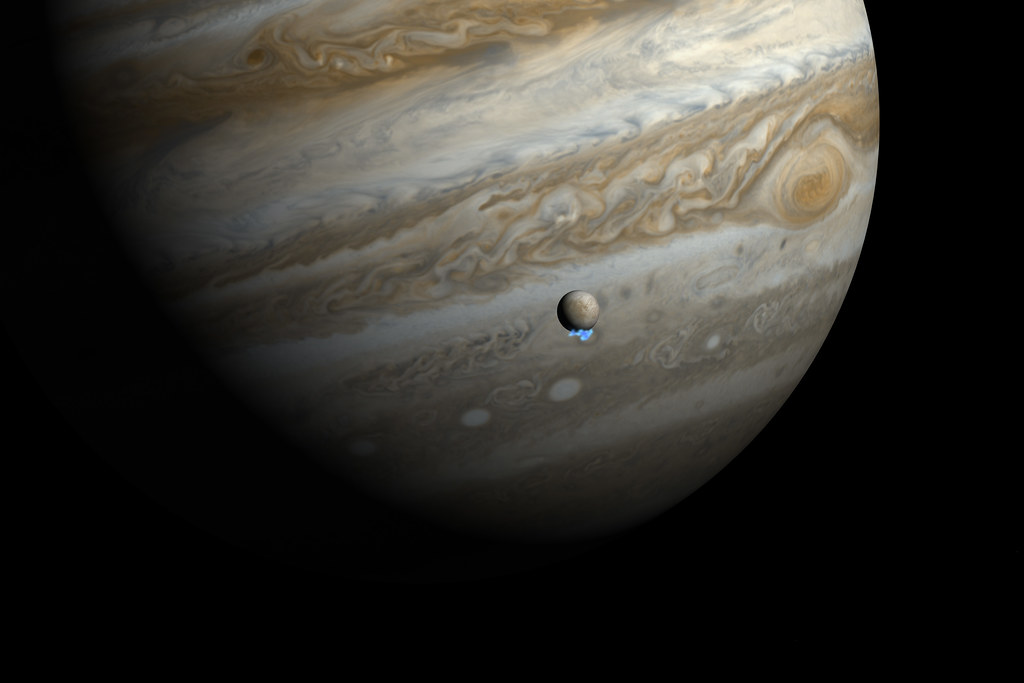The Moon and Jupiter
Let’s start with a little trivia. September 16th's Full Moon is the so-called Harvest Moon (occasionally the Corn Moon). We are approaching the Fall Equinox, and the Moon’s orbit keeps it visible from evening to evening a bit longer than at other times of the year. Before modern lighting, this meant that the fall harvest could be taken in with the help of moonlight, giving farmers more time each day to do so. Hence, the label “Harvest Moon.”
The highlight of the night sky right now is Jupiter, shining very brightly in the east southeast. It rises just after 8 p.m. Jupiter will make a lovely pairing with the Full Moon when the Moon will be just to the right of Jupiter - the brightness of Jupiter will make it a suitable companion. Sunday the 17th evening, the Moon will have moved almost the same distance to the other side of Jupiter.
Jupiter is as bright as it is right now, since it is approaching opposition, which means it will be directly opposite Earth from the Sun on September 26, and will therefore be highest in the sky near midnight over the next few weeks.
With a pair of binoculars, you can often see the four bright Moons of Jupiter, as they perform a dance around it from night to night (but I would wait a couple days until the bright Moon isn’t so close by). If you don’t see all four, one or more of them may be directly in front or behind Jupiter. Sometimes they will be all to one side or the other of Jupiter, but you can see their changes easily from night to night.
Saturn
Saturn is nowhere near as bright as Jupiter, but if you look towards the south southeast in the evening, you might see one “star” that is clearly brighter than the others. That is Saturn, sitting about 20 degrees above the horizon around 10 p.m., which is a little less than the distance from your thumb to your little finger on an outstretched hand at arm’s length. With a spotting scope, you might be able to discern the slight bulge in its shape due to its rings, or perhaps you might even be able to make out the rings themselves.
Venus
Venus is visible in the predawn light, low in the east. Since Venus is rising just before 6 a.m., it will be hard to spot it unless you have a good low horizon.
A sure sign of Winter
If you are up in the early hours before sunrise, you may see the three stars that form the belt of Orion rising in the east. Orion is a distinctly winter constellation, and it will be rising earlier and earlier until by the beginning of November Orion will be rising before midnight.
The International Space Station
For those of us on Vancouver Island and the lower BC mainland, we will have few nice evening passes of the Space Station over the next ten days or so. There will be other passes, but these are the best.
On Thursday, Sept. 15, ISS will rise in the southwest at 8:52 p.m. It will remain quite low in the southern sky. What makes this pass special is that just after it passes above Saturn, it will fade from the sky as it enters Earth’s orbit.
ISS will do another nice disappearing act on Friday, Sept. 16. It will rise in the west southwest at 9:40, and just three minutes or so later, when it’s about half way up the southwestern sky, it will fade from sight.
Saturday (Sept 17) will give us a nice bright pass. ISS rises in the southwest at 8:51, climbs nicely up the southern sky, passing very close to the bright star Altair, which is the bottom star of the so-called Summer Triangle. Look above that, more than the width of your outstreched hand for two other very bright stars that make up the triangle. As it approaches Jupiter, but higher in the sky than Jupiter, it will fade from sight at 8:57.
Sunday (Sept 18) will give us two chances to see the ISS. ISS will first rise in the southwest at 8:03. It will cross the southern sky, a bit below Altair, and after passing above Jupiter in the east, it will fade from sight just above the horizon.
Since the ISS orbits the Earth about every 90 minutes, it will come back around again, rising in the west at 9:40. This will be a short pass, climbing nicely up the north northwest sky before fading from sight at 9:44.
The brightest pass of this series will be on Monday, Sept. 19, when ISS will rise in the west at 8:51, climb very high overhead, a bit to the north (not too far from the top stars of the Summer Triangle), and then fade from sight in the east northeast at 8:57.
Clear skies.
David


No comments:
Post a Comment